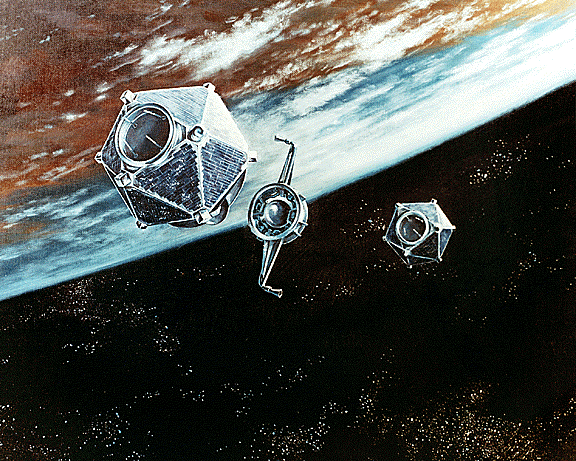36 years ago today, a strange event was detected over the Southern Indian Ocean that remains controversial. On September 22
nd
, 1979, an American Vela Hotel satellite detected an atmospheric explosion over the southern Indian Ocean near the Prince Edward Islands. The event occurred at 00:53 Universal Time on the pre-dawn nighttime side of the Earth. Vela's gamma-ray and x-ray detectors rang out in surprise, along with its two radiometers (known as
Bhangmeters
) which also captured the event.
[caption id="attachment_122463" align="alignnone" width="488"]
The approximate location of the flash seen by the Vela-5b satellite Image credit: Wikimedia Commons/public domain[/caption]
What was it?
Even today, the source of the Vela Incident remains a mystery. Designed to detect nuclear detonations worldwide and enforce the Partial Nuclear Test Ban Treaty, the Vela satellites operated for about ten years and were also famous for discovering evidence for extra-galactic gamma-ray bursts.
[caption id="attachment_122461" align="aligncenter" width="461"]
A Vela payload in the lab. Image credit: The U.S. Department of Defense[/caption]
Vela-5B was the spacecraft from the series that detected the mysterious flash. A Titan-3C rocket launched Vela 5B (NORAD ID 1969-046E) on May 23
rd
, 1969 from Vandenberg Air Force Base in California.
One of the first things scientists realized early on in the Cold War is that the Universe is a noisy place, and that this extends across the electromagnetic spectrum. Meteors, lightning, cosmic rays and even distant astrophysical sources can seem to mimic certain signature aspects of nuclear detonations. The ability to discern the difference between human-made and natural events became of paramount importance and remains so to this day: the hypothetical scenario of a Chelyabinsk-style event over two nuclear armed states already on a political hair-trigger edge is a case in point.
Over the years, the prime suspect for the Vela Incident has been a joint South African-Israeli nuclear test. The chief piece of evidence is the characteristic 'double-flash' recorded by Vela, characteristic of a nuclear detonation. Said event would've been an approximately 3 kiloton explosion; for context, the bomb dropped on Hiroshima had a 15 kiloton yield, and the
Chelyabinsk event
had an estimated equivalent explosive force of 500 kilotons. As a matter of fact, the Vela Incident became a topic of discussion on the day Chelyabinsk occurred, as we sought to verify the assertion of whether Chelyabinsk was 'the biggest thing' since the 1908 Tunguska event.
[caption id="attachment_122465" align="alignnone" width="580"]
A bolide event captured over Pennsylvania in early 2015. Image credit: Bill Ingalls/NASA[/caption]
The Carter administration played down the
Vela Incident
at the time, though U.S. Air Force dispatched several WC-135B surveillance aircraft to the area, which turned up naught. Though detectors worldwide reported no increase of radioactive fallout, the ionospheric observatory at Arecibo did detect an atmospheric wave on the same morning as the event.
Israel ratified the
Limited Test Ban Treaty
in 1964. To date, Israel has never acknowledged that the test took place or the possession of nuclear weapons. Over the years, other suspect states have included Pakistan, France and India. Today, probably the only true final confirmation would come from someone stepping forward who was directly involved with the test, as it must have required the silence of a large number of personnel.
[caption id="attachment_122464" align="alignnone" width="580"]
A comparison of the Vela event with a known nuclear test and a typical "zoo event'.
- Image credit
-
Vela Event Alert 747, Los Alamos Nat'l Laboratory[/caption]
Was it a reentry or a bolide? Again, the signature double flash seen by the Vela satellite makes it unlikely. A micrometeoroid striking the spacecraft could have caused an anomalous detection known as a 'zoo event,' mimicking a nuclear test. Los Alamos researchers who have analyzed the event over the years remain convinced in the assertion that the 1979 Vela Incident had all the hallmark signatures of a nuclear test.
[caption id="attachment_122462" align="aligncenter" width="580"]
A U.S. nuclear detonation during Operation Upshot-Knothole in 1953.
- Image credit
-
National Nuclear Security Administration/Public Domain[/caption]
Shortly after the Cold War, the U.S. Department of Defense made much of its atmospheric monitoring data public, revealing that small meteorites strike us much more often than realized. Sadly, this type of continual monitoring accompanied by
public data release
has declined in recent years mostly due to budgetary concerns, though monitoring of the worldwide environment for nuclear testing via acoustic microphone on land, sea and eyes overhead in space continues.
And it's frightening to think how close we came to a nuclear exchange during the Cold War on several occasions. For example: in 1960, an Distant Early Warning System based in Thule, Greenland mistook the rising Moon for a Soviet missile launch (!) The United States also conducted nuclear tests in space shortly before the Test Ban Treaty went into effect, including Starfish Prime:
The Vela Incident remains a fascinating chapter of the Cold War, one where space and the geopolitical intrigue overlap. Even today, parsing out the difference between human-made explosions and the cataclysmic events that pepper the cosmos remains a primary concern for the continued preservation of our civilization.
[caption id="attachment_122466" align="alignnone" width="580"]
Tactical nuclear weapons from around the world seen on display at the Nuclear Science Museum in Albuquerque, New Mexico. Image credit: Dave Dickinson[/caption]
-Listen to an
interesting discussion
on monitoring nuclear plants worldwide via neutrino emissions.
-For a fascinating in-depth discussion on the continued relevance of the Vela Incident, check out this
recent article
by The Bulletin of Atomic Scientists.
 Universe Today
Universe Today
